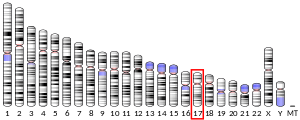TIAF1
TGFB1-induced anti-apoptotic factor 1 is a protein that in humans is encoded by the TIAF1 gene.[3][4]
| TIAF1 | |||||||||||||||||||||||||
|---|---|---|---|---|---|---|---|---|---|---|---|---|---|---|---|---|---|---|---|---|---|---|---|---|---|
| Identifiers | |||||||||||||||||||||||||
| Aliases | TIAF1, MAJN, SPR210, TGFB1-induced anti-apoptotic factor 1 | ||||||||||||||||||||||||
| External IDs | OMIM: 609517 HomoloGene: 130531 GeneCards: TIAF1 | ||||||||||||||||||||||||
| |||||||||||||||||||||||||
| |||||||||||||||||||||||||
| Orthologs | |||||||||||||||||||||||||
| Species | Human | Mouse | |||||||||||||||||||||||
| Entrez |
| ||||||||||||||||||||||||
| Ensembl |
| ||||||||||||||||||||||||
| UniProt |
| ||||||||||||||||||||||||
| RefSeq (mRNA) |
| ||||||||||||||||||||||||
| RefSeq (protein) |
| ||||||||||||||||||||||||
| Location (UCSC) | Chr 17: 29.07 – 29.08 Mb | n/a | |||||||||||||||||||||||
| PubMed search | [2] | n/a | |||||||||||||||||||||||
| Wikidata | |||||||||||||||||||||||||
| |||||||||||||||||||||||||
Interactions
TIAF1 has been shown to interact with Janus kinase 3[5] and TRIB3.[6]
gollark: I could have the server send pings, but I don't think the client Lua code can see them and if it's disconnected then the client Java code won't know it's meant to respond ~~with~~ to one.
gollark: Pings exist but I don't think they happen automatically and CC can't trigger them.
gollark: I'd probably also add pings for autoreconnect, UUIDs for messages, maaaaybe a paired fallback server, and set_channels instead of open and close.
gollark: (skynetv2 is the current one, v3 is hypothetical future skynet)
gollark: SPUDNET, which has more active evolution and also possibly asynchronous commands, does have a command ID option in its v4 protocol, which could be backported to skynetv3 or something.
References
- GRCh38: Ensembl release 89: ENSG00000221995 - Ensembl, May 2017
- "Human PubMed Reference:". National Center for Biotechnology Information, U.S. National Library of Medicine.
- Chang NS, Mattison J, Cao H, Pratt N, Zhao Y, Lee C (December 1998). "Cloning and characterization of a novel transforming growth factor-beta1-induced TIAF1 protein that inhibits tumor necrosis factor cytotoxicity". Biochemical and Biophysical Research Communications. 253 (3): 743–9. doi:10.1006/bbrc.1998.9846. PMID 9918798.
- "Entrez Gene: TIAF1 TGFB1-induced anti-apoptotic factor 1".
- Ji H, Zhai Q, Zhu J, Yan M, Sun L, Liu X, Zheng Z (April 2000). "A novel protein MAJN binds to Jak3 and inhibits apoptosis induced by IL-2 deprival". Biochemical and Biophysical Research Communications. 270 (1): 267–71. doi:10.1006/bbrc.2000.2413. PMID 10733938.
- Zhou Y, Li L, Liu Q, Xing G, Kuai X, Sun J, Yin X, Wang J, Zhang L, He F (May 2008). "E3 ubiquitin ligase SIAH1 mediates ubiquitination and degradation of TRB3". Cellular Signalling. 20 (5): 942–8. doi:10.1016/j.cellsig.2008.01.010. PMID 18276110.
Further reading
- Nagase T, Seki N, Ishikawa K, Ohira M, Kawarabayasi Y, Ohara O, Tanaka A, Kotani H, Miyajima N, Nomura N (October 1996). "Prediction of the coding sequences of unidentified human genes. VI. The coding sequences of 80 new genes (KIAA0201-KIAA0280) deduced by analysis of cDNA clones from cell line KG-1 and brain". DNA Research. 3 (5): 321–9, 341–54. doi:10.1093/dnares/3.5.321. PMID 9039502.
- Ji H, Zhai Q, Zhu J, Yan M, Sun L, Liu X, Zheng Z (April 2000). "A novel protein MAJN binds to Jak3 and inhibits apoptosis induced by IL-2 deprival". Biochemical and Biophysical Research Communications. 270 (1): 267–71. doi:10.1006/bbrc.2000.2413. PMID 10733938.
- Mori K, Furusawa T, Okubo T, Inoue T, Ikawa S, Yanai N, Mori KJ, Obinata M (April 2003). "Genome structure and differential expression of two isoforms of a novel PDZ-containing myosin (MysPDZ) (Myo18A)". Journal of Biochemistry. 133 (4): 405–13. doi:10.1093/jb/mvg053. PMID 12761286.
- van der Leij J, van den Berg A, Albrecht EW, Blokzijl T, Roozendaal R, Gouw AS, de Jong KP, Stegeman CA, van Goor H, Chang NS, Poppema S (June 2003). "High expression of TIAF-1 in chronic kidney and liver allograft rejection and in activated T-helper cells". Transplantation. 75 (12): 2076–82. doi:10.1097/01.TP.0000069829.71088.88. PMID 12829915.
- Brajenovic M, Joberty G, Küster B, Bouwmeester T, Drewes G (March 2004). "Comprehensive proteomic analysis of human Par protein complexes reveals an interconnected protein network". The Journal of Biological Chemistry. 279 (13): 12804–11. doi:10.1074/jbc.M312171200. PMID 14676191.
- Bouwmeester T, Bauch A, Ruffner H, Angrand PO, Bergamini G, Croughton K, Cruciat C, Eberhard D, Gagneur J, Ghidelli S, Hopf C, Huhse B, Mangano R, Michon AM, Schirle M, Schlegl J, Schwab M, Stein MA, Bauer A, Casari G, Drewes G, Gavin AC, Jackson DB, Joberty G, Neubauer G, Rick J, Kuster B, Superti-Furga G (February 2004). "A physical and functional map of the human TNF-alpha/NF-kappa B signal transduction pathway". Nature Cell Biology. 6 (2): 97–105. doi:10.1038/ncb1086. PMID 14743216.
- Schultz L, Khera S, Sleve D, Heath J, Chang NS (January 2004). "TIAF1 and p53 functionally interact in mediating apoptosis and silencing of TIAF1 abolishes nuclear translocation of serine 15-phosphorylated p53". DNA and Cell Biology. 23 (1): 67–74. doi:10.1089/104454904322745943. PMID 14965474.
- Homma K, Kikuno RF, Nagase T, Ohara O, Nishikawa K (November 2004). "Alternative splice variants encoding unstable protein domains exist in the human brain". Journal of Molecular Biology. 343 (5): 1207–20. doi:10.1016/j.jmb.2004.09.028. PMID 15491607.
- Isogawa Y, Kon T, Inoue T, Ohkura R, Yamakawa H, Ohara O, Sutoh K (April 2005). "The N-terminal domain of MYO18A has an ATP-insensitive actin-binding site". Biochemistry. 44 (16): 6190–6. doi:10.1021/bi0475931. PMID 15835906.
- Olsen JV, Blagoev B, Gnad F, Macek B, Kumar C, Mortensen P, Mann M (November 2006). "Global, in vivo, and site-specific phosphorylation dynamics in signaling networks". Cell. 127 (3): 635–48. doi:10.1016/j.cell.2006.09.026. PMID 17081983.
This article is issued from Wikipedia. The text is licensed under Creative Commons - Attribution - Sharealike. Additional terms may apply for the media files.

